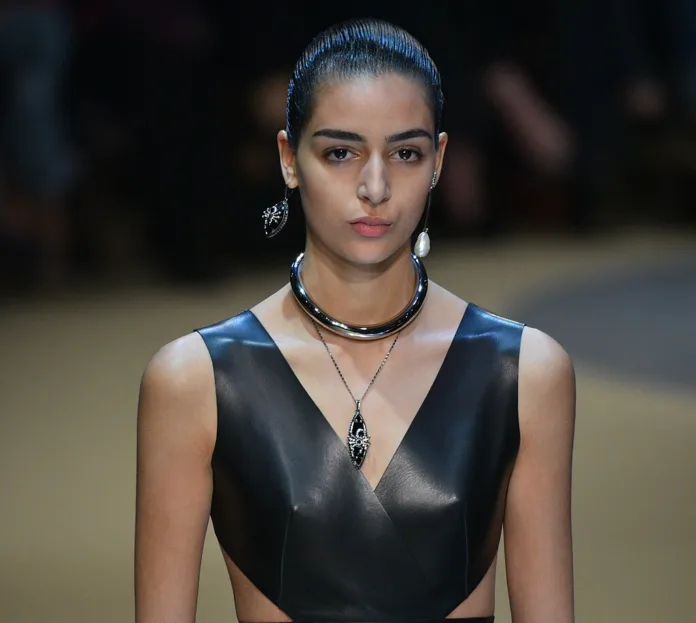Arab models, including Loli Bahia, Mona Tougaard, Amira al-Zuhair, and Nora Attal, turned heads with bold, high-fashion looks at Milan’s most prestigious runway shows
Arab models made a powerful statement on the international stage at Milan Fashion Week 2024, captivating audiences with their grace and style as they walked for top designers like Gucci and Missoni. This year’s spring/summer 2025 collections saw these models not only enhancing the collections but also redefining beauty standards in the global fashion industry.
French Algerian model Loli Bahia dazzled in Gucci’s show with a striking charcoal grey outfit that featured a tailored zip-up jacket with a prominent, pointed collar. The jacket’s slightly oversized fit gave it a relaxed yet structured silhouette, perfectly complemented by matching wide-leg trousers. Bahia’s ensemble was accessorized with a sleek, metallic choker and white loafers with black details, embodying the brand’s vision of “Casual Grandeur” for the season.
Embed from Getty ImagesJoining Bahia on the Gucci runway was Danish-Turkish-Somali-Ethiopian model Mona Tougaard, who stunned in a sleeveless white dress with a high neckline and a dramatic thigh-high slit. Paired with glossy black knee-high leather boots and chunky heels, her look was completed with bold gold jewellery, including a choker and matching bracelets. The Gucci show was a celebration of vintage-inspired yet modern styles, featuring draped dresses, structured jackets, and a 1960s-inspired palette that included shades of grey, brown, green, orange, and red.
Meanwhile, the Missoni runway welcomed part-Saudi model Amira Al-Zuhair, who wowed the crowd in a dynamic and eye-catching outfit featuring bold, wavy stripes in black, white, and yellow. Her asymmetrical top, adorned with exaggerated ruffles, paired with a high-waisted bikini bottom, created a striking silhouette. Vibrant yellow high-heeled sandals added a burst of colour, ensuring that Al-Zuhair’s look stood out.
British Moroccan model Nora Attal also delivered a show-stopping appearance at Missoni. She stepped onto the runway in a vibrant one-shoulder top with wavy stripes of black, white, red, yellow, and blue. The sharp, asymmetrical hem of the top paired seamlessly with high-waisted leggings that echoed the bold colour palette through color-blocked panels. Classic black pointed-toe heels completed her look, cementing her place as a standout on the runway.
Milan Fashion Week 2024 highlighted the rising prominence of Arab models in the fashion world. Their participation reflects not only the industry’s growing diversity but also the global demand for varied representations of beauty, style, and culture.
Analysis:
Political
The participation of Arab models at a prestigious event like Milan Fashion Week highlights the increasing global acceptance of diversity in fashion. Countries in the Middle East, particularly Saudi Arabia, are undergoing cultural transformations, embracing more progressive views on women’s roles in public spaces. The visibility of Arab women on such an international platform mirrors these changes and adds to the Kingdom’s broader push to enhance its global image through cultural diplomacy. Models like Amira Al-Zuhair and Nora Attal serve as symbols of this evolving narrative, breaking barriers and representing the modern Arab woman in a global context.
Social
The presence of Arab models on Milan’s runways signifies a shift in the fashion industry toward more inclusivity. Traditionally dominated by Western beauty standards, fashion houses are now increasingly spotlighting models from diverse ethnic and cultural backgrounds. This trend reflects broader societal changes, where audiences demand to see more diverse representations of beauty. Arab models, with their unique features and rich cultural backgrounds, are playing a vital role in this shift, pushing the boundaries of what is considered fashionable and redefining the global beauty standard. By representing a wide array of backgrounds, these models challenge outdated notions and promote a more inclusive vision of fashion.
Racial
Arab models walking the runways at Milan Fashion Week is a clear indication of the industry’s growing embrace of racial diversity. The fashion world, once criticized for its lack of representation, is now beginning to reflect the racial and cultural diversity of its global consumer base. Arab models like Loli Bahia and Mona Tougaard are not just breaking into the industry; they are excelling, showcasing the beauty and elegance of different racial and ethnic groups. Their presence helps normalize the inclusion of non-white models in high fashion, providing inspiration for other models from underrepresented backgrounds to pursue their careers in fashion.
Gender
The prominence of Arab models in Milan highlights the evolving role of women in both fashion and society, particularly in the Arab world. The success of these models challenges the traditional gender roles often associated with women in the Middle East. Models like Amira Al-Zuhair and Nora Attal are paving the way for future generations of Arab women, showing that they can excel in global industries like fashion while maintaining their cultural identities. Their success also highlights how fashion is becoming an avenue for female empowerment, offering women greater visibility and control over how they present themselves to the world.
Economic
The fashion industry is an economic powerhouse, generating billions of dollars globally. Milan Fashion Week, one of the most prominent events in the fashion calendar, draws attention from all corners of the world, from buyers to designers and influencers. The participation of Arab models at such a high-profile event speaks to the growing economic influence of the Middle East in global industries like fashion. Countries like Saudi Arabia are actively investing in the arts and entertainment sectors as part of broader economic diversification efforts under Vision 2030. As fashion becomes more inclusive and diverse, the representation of Arab models is not only a cultural milestone but also an indicator of the growing financial integration of the Middle East into the global fashion economy.
